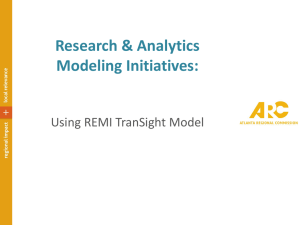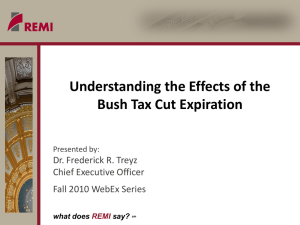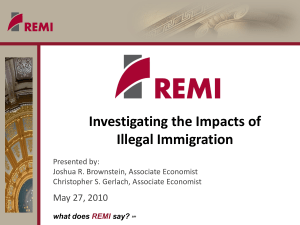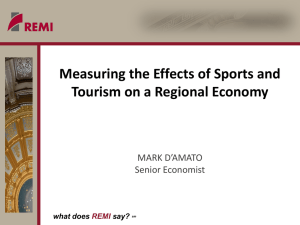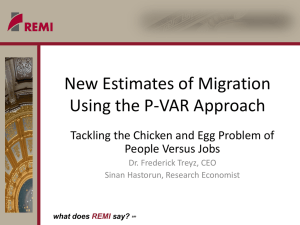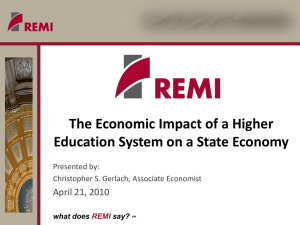(and State) REMI Experiment - Regional Economic Models, Inc.
advertisement
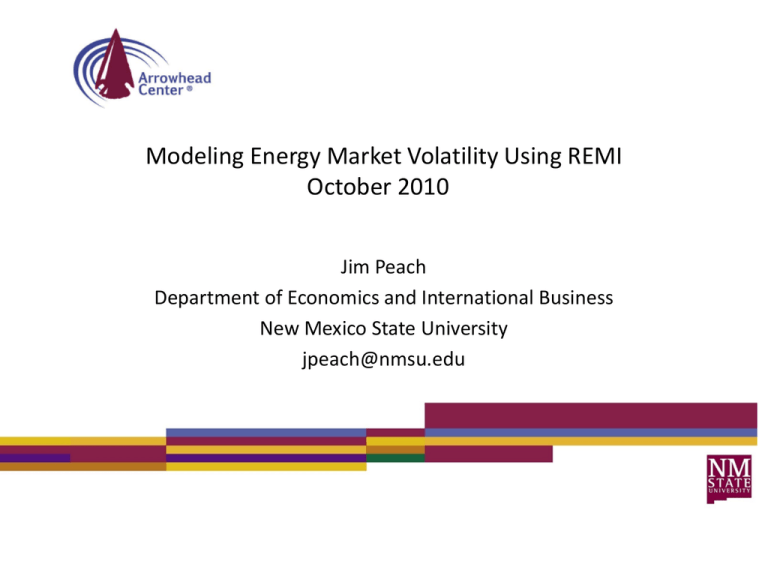
Modeling Energy Market Volatility Using REMI October 2010 Jim Peach Department of Economics and International Business New Mexico State University jpeach@nmsu.edu Some Background on Energy Market Volatility (EMV) • EMV is defined here to include price, employment, and output volatility • EMV appears more likely than energy market stability • EMV creates direct and indirect impacts on – Output, employment, and income – State revenues e.g., severance tax revenue • REMI standard controls (state and national) are “smooth” • EMV can be modeled in REMI using relatively simple techniques Some Specifics • Energy Prices in real (and nominal) terms are highly variable – Including oil, natural gas, uranium, and coal • Domestic output in physical quantities is less variable than prices Real Oil Price Volatility 2000 to 2009 Annual Percent Change in West Texas Intermediate Real Price Sources: WTI prices from EIA, Short Term Energy Outlook, Table 2 and GDP deflator from Bureau of Economic Analysis, NIPA Tables 1.1.9 Natural Gas Price Variability: 2000 to 2009 Annual Percent Change in Real ($2005) Henry Hub Spot Price Sources: WTI prices from EIA, Short Term Energy Outlook, Table 2 and GDP deflator from Bureau of Economic Analysis, NIPA Tables 1.1.9 Coal Price Volatility: 2000 to 2009 Annual Percent Change In Real Coal Price ($2005 Per short ton) Sources: Coal prices from EIA, Annual Energy Review (2010), Table 7.8 and GDP deflator from Bureau of Economic Analysis, NIPA Tables 1.1.9 Uranium (Spot Price) Variability: 2000 to 2009 Annual Percent Change U308 Spot Price Real ($2005) Sources: Uranium Prices from EIA Uranium Annual Marketing Report 2010, Table S1b GDP deflator from Bureau of Economic Analysis, NIPA Tables 1.1.9 Output and Price • Domestic output in physical quantities is less variable than prices – Once the well is drilled . . . • Marginal cost is relatively low • Shut down/start-up costs substantial – Contract deliveries . . . • Consider coal or uranium production – Futures markets, hedge funds, etc. – Continuity of labor force: • Skilled workers, service providers, etc U.S. Oil Prices and Production: 2000 to 2009 Percent Change US Oil Production and Real ($2005) WTI Price Source: Oil Production: EIA Petroleum Navigator, Crude Oil Production WTI Price and Deflator: See Previous Figure. US Natural Gas Prices and Production Percent Change in Natural Gas Production and Henry Hub Real ($2005) Price Source: Natural Gas Production: EIA Natural Gas Navigator Natural Gas Wellhead Value and Marketed Production Prices and Deflator: See Previous Figures Some (Very) Direct Impacts (Oil and Gas Price Volatility) • State Tax Revenue – “High reliance on O&G revenues creates two challenges for the state: revenue volatility and long-run sustainability” • Tom Clifford, Chief Economist, New Mexico Legislative Finance Committee, August 5, 2010. – Severance and other production taxes – But don’t forget CIT, PIT, GRT • Rig counts – Exploration and drilling are highly price sensitive • Employment in oil and gas extraction – NAICS Code ( 211) • Need more –Long list of indirect and dynamic effects New Mexico Oil and Gas Revenues as Percent of General Fund Source: New Mexico Department of Finance, Consensus Revenue Forecast (2009, Figure 12, p. 14) U.S. Oil Rig Counts and WTI Prices Oil Rig Activity and Real Oil Prices Index Numbers Source: Index numbers (2000=100) calculated by author. Rig Data EIA Petroleum Navigator, Crude Oil and Natural Gas Drilling Activity Price: See Previous Figures Natural Gas Rigs and Natural Gas Prices US Natural Gas Rigs and Henry Hub Spot Prices (Real($2005) Index Numbers (2000 = 100) Source: See previous figure. Employment in Oil and Gas Extraction (NAICS 211) REMI Data Percent Change Employment NM and US Oil and Gas Extraction Source: REMI PI+ standard controls Oil and Gas Extraction Employment and Prices Percent Change In Employment Index and Weighted Oil and Gas Price Index Source: Author Calculations from BEA and EIA Data Price index weighted by BTU equivalent production levels EIA Confidence Intervals for WTI REMI Oil and Gas Extraction Employment Standard National Control REMI Oil and Gas Extraction Employment Standard Regional Control New Mexico Why is this important? • • • • The next slide contains employment “multipliers” for selected industries Computed from REMI Standard National Control Assumes 1% change in employment in sector listed Computed as: Change in total employment divided by Change in employment in sector listed Example (Construction Sector): 921.922/437.519 = 2.11 Where 921.922 = difference from REMI baseline in total employment 437.519 = 1% difference from REMI baseline in Construction Employment Selected Industry Total Employment Multipliers: REMI Standard National Control The employment multipliers represent the estimated impact of an additional job in the sector listed on total employment Source: Author calculations using REMI PI+ standard national control. Multipliers are for 2010. Many Options to Model Energy in REMI • Relative fuel costs, relative delivered prices, cost of production, • Fuel Weight data (shares natural gas, electricity, residual) • Consumption patterns – – – – – Gasoline and oil Fuel oil and coal Electricity Gas Several transportation related categories • Trade flows – Rest of nation and rest of world • Modify intermediate demand, etc. • Create New Industry – e.g. uranium mining and milling (NAICS 212291) – Petroleum refineries (NAICS 32411) Modeling Options Continued • Industry specific employment / output changes in many sectors – – – – – – Oil and gas extraction (NAICS211) Coal mining (NAICS 2121) Electric power generation, transmission and Distribution (NAICS 2211) Natural gas distribution (NAICS 2212) Petroleum and coal products manufacturing (NAICS 324) Pipeline transportation (NAICS 486) A National (and State) REMI Experiment: and some implications for New Mexico • Step 1: Create new national control – Impose the variability (% change) in oil and gas employment observed from 2000 to 2009 on projected years 2010 to 2019. • Step 2: Run regional model using new national control – With no other changes to the regional model A National (and State) REMI Experiment: Step 1 Create New National Control Can also be done through labor demand block A National (and State) REMI Experiment: Step 1 National results Net Change in Oil and Gas Employment 2010-2019 = 179.2k jobs A National (and State) REMI Experiment: Step 1 National results Net Change in Total Employment 2010-2019 = 1.6 million jobs Net Change in RGDP 2010-2019 = $158 Billion A National (and State) REMI Experiment: Step 2 New Mexico Results Net Change in Total Employment 2010-2019 = 21.2 K jobs Net Change in RGDP 2010-2019 = $1.5 Billion A National (and State) REMI Experiment: Step 2 New Mexico results Range in Oil and Gas Employment -9.56 % to + 16.63% A National (and State) REMI Experiment: Pros and Cons • Advantages of this technique: – It is easy –very easy– to implement – It does capture historic variability that is not captured in the standard controls • and, it makes a difference in the results • Disadvantages – Timing –who knows when the variability will occur? A Second National (and State) REMI Experiment: Also Easy • Use μ (mean) and σ (standard deviation) of previous decade variability – Or some other plausible μ and σ • Draw random numbers from this distribution to obtain inputs – Assume the distribution is normal – or some other distribution since the world is not normal • Construct new national control • Examine impacts at state level – No other changes at state level A Second National (and State) REMI Experiment: Inputs used in EMPL in oil and gas extraction sector Compared to implied historic A Second National (and State) REMI Experiment: Results: % Chg from Standard Regional Control Total Employment and RGDP Net Change in NM Total Employment = 19.6k jobs Net change in NM Oil and Gas Employment = 3.1 k jobs A Second National (and State) REMI Experiment: Results: % Chg from Standard Regional Control Oil and Gas Extraction Employment and Other Sectors A Monte Carlo National (and State) REMI Experiment: Fun, but don’t try this one …. • Use μ (mean) and σ (standard deviation) of previous decade variability – Or some other plausible μ and σ • Draw 100 (250?) random samples (see next slide) – from normal or some other distribution • Run the previous experiment in REMI using each sample • Save the results • Construct interval estimates – Many ways to do this Who are these guys? They are “Arrowhead slaves” who did the 250 REMI runs. Mikidadu Mohammed, Graduate Student Leo Delgado, Policy Analyst A Monte Carlo National (and State) REMI Experiment: What the spreadsheet might look like A Monte Carlo National (and State) REMI Experiment: Some Interval Estimates Ranges shown are in percentage differences in New Mexico Oil and Gas Extraction employment. The 12 highest and 12 lowest observations were removed. A Monte Carlo National (and State) REMI Experiment: Some More Interval Estimates Notice the change In scale from the Previous chart Ranges shown are percentage differences in New Mexico Oil and Gas Extraction employment. These are the maximum and minimum ranges from 250 trials. A Monte Carlo National (and State) REMI Experiment: Advantages and Disadvantages • Advantages – Explicit recognition that: • Energy Market Variability (EMV) is likely • The timing (years) is unknown and unknowable – Produces a plausible(?) range of estimates rather than a point estimate – Satisfies ceremonial requirements of complexity and sophistication • Disadvantages – – – – – – – The intervals are far too large to be meaningful? Not necessary due to linearity of REMI responses Time consuming (expensive) Distributional assumption or The World is Not Normal Stationarity of μ and σ Other less time consuming methods to generate intervals The intervals do not get larger as t gets larger Some Conclusions • Variability matters – even in a relatively short (10 year) time horizon – even when only oil and gas extraction is considered • Variability here to stay? – More than likely • Not difficult to impose some variability on the standard controls • Key questions – How much variability? – When will it occur? • Answers to key questions are unknown and unknowable – but this should not deter some attempt to impose variability – when stability (smoothness) seems rare

